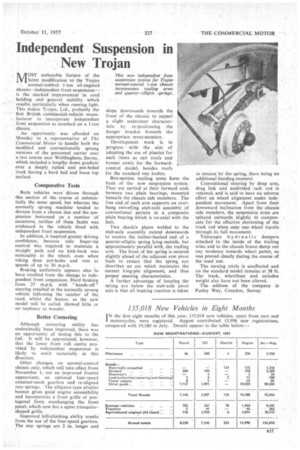Independent Suspension in New Trojan
Page 69

If you've noticed an error in this article please click here to report it so we can fix it.
MOST noticeable feature of the latest modification to the Trojan
• normal-control • 1-ton oil-engined chassis—independent front suspension— is the marked improvement in road holding and -general stability which results, particularly when running light. This makes Trojan, Ltd., probably the first British. cotninercial-Vehicle manufacturer to incorporate independent front suspension as standard on a 1-ton chassis. •
An opportunity was afforded on Monday to a representative of The ,Commercial Motor to handle both the modified and conventionally sprung versions of the personnel carrier over a test course near Woldingham, Surrey, which included a lengthy down gradient over a deeply rutted and pot-holed track having a hard bed and loose top surface.
Comparative Tests
Both vehicles were' driven through This section of the course at substantially the same speed, but whereas the normally sprung machine tended to deviate from a chosen line and the suspension bottomed on a number of occasions, neither of these faults was evidenced in the vehicle fitted with independent front suspension.
In addition, it inspired greater driving confidence, because only finger-tip control was required to maintain a straight path and no kick-back was noticeable at the wheel, even when taking deep pot-holes and ruts at speeds of up to 30 m.p.h.
Braking uniformity appears also to have resulted from the change to independent front suspension. Hard braking from 25 .m.p.h. with " hands-off " steering resulted in the normally sprung vehicle following the camber of the road, whilst the Senior, as the new model will be called, showed little or no tendency to wander.
Better Cornering
Although cornering ability has undoubtedly been improved, there was no opportunity of testing this to the full. It will be appreciated, however, that the lower front roll centre provided by independent suspension is likely to assist materially in this direction.
Other changes, on normal-control chassis only, which will take effect from November 1, are an improved frontal appearance, an optional four-speed constant-mesh gearbox and re-aligned rear springs. The alligator-type plastics bonnet gives good engine accessibility and incorporates a front grille of pentagonal form overhanging the front panel, which now has a squat triangularshaped grille.
Improved hill-climbing ability results from the use of the four-speed gearbox. The rear springs are 2 in. longer and slope downwards towards the front of the chassis to impart a slight understeer characteristic by re-positioning the hanger bracket beneath the appropriate cross-member.
Development work is in progress with the aim of adopting the use of plastics for such items as cab roofs and bonnet cowls for the forwardcontrol model, besides roofs for the standard van bodies.
Box-section trailing arms form basis of the new suspension system. ' They are carried at their forward ends between two plain bearings, mounted beneath the chassis side members. The free end of each arm supports an overhung swivelling stub-axle assembly of conventional pattern in a composite plain bearing which is co-axial with the hub.
Two shackle plates welded to the stub-axle assembly extend downwards to receive the rubber-bushed end of a quarter-elliptic spring lying outside, but approximately parallel with, the trailing arm. The front of the spring is secured slightly ahead of the adjacent arm pivot bush to ensure that the spring eye describes an arc which maintains the correct king-pin alignment, and thus proper steering characteristics.
. A further advantage of locating the spring eye below the stub-axle pivot axis is that all braking reaction is taken in tension by the spring„ there being no the additional bending moment.
Conventional steering by drop arm, drag link and undivided rack rod is retained, and is said to have no adverse effect on wheel alignment under independent movement. Apart from their downward inclination from the chassis side members. the suspension arms are splayed outwards slightly to compensate for the effective shortening of the track rod when only one wheel travels through its full movement.
Telescopic hydraulic dampers attached to the inside of the trailing arms and to the chassis frame damp out any tendency towards wheel patter, as was proved clearly during the course of the road test.
The turning circle is unaffected and on the standard model remains at 38 ft. The track, wheelbase and unladen weight also have not been altered.
The address of the company is Purley Way, Croydon, Surrey.




















































































































